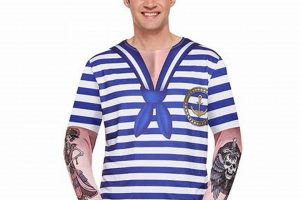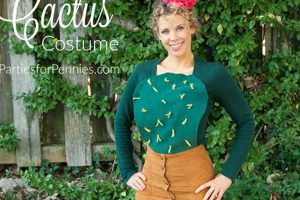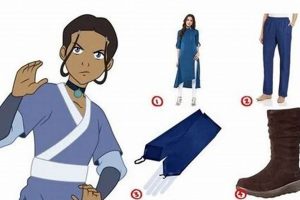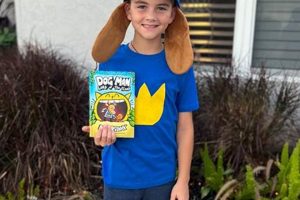Creating a handmade representation of the ragdoll character Sally, from Tim Burton’s “The Nightmare Before Christmas,” involves the application of do-it-yourself techniques. This frequently includes crafting a patchwork dress, replicating her distinctive makeup, and styling her signature red hair, utilizing readily available materials and personal creativity to achieve the desired look.
The practice offers several advantages, notably cost-effectiveness, as it bypasses the expense associated with professionally manufactured costumes. Furthermore, it fosters individual expression, enabling modification and personalization of the character’s depiction to align with one’s artistic vision. Historically, individuals have often resorted to homemade costuming solutions for theatrical productions, festive events, or personal enjoyment, driven by budgetary constraints or a desire for unique designs.
Subsequent sections will detail specific approaches to constructing the various elements of the character’s attire, encompassing dress design, makeup application, and hair styling. Each section will provide step-by-step guidance and resource suggestions to facilitate successful execution.
Essential Guidance for Handmade Ragdoll Character Attire
The following directives are designed to assist in the successful creation of a costume inspired by the ragdoll character, focusing on accuracy and durability.
Tip 1: Fabric Selection: Prioritize durable fabrics for the patchwork dress. Cotton or linen blends are recommended for their longevity and ease of manipulation. Diverse textures and patterns will enhance the visual complexity of the garment.
Tip 2: Pattern Construction: Employ a pre-existing dress pattern as a foundation or draft a custom pattern based on accurate measurements. Ensure a comfortable fit, allowing for ease of movement and wear. The pattern should accommodate the planned patchwork design.
Tip 3: Stitching Techniques: Utilize strong and secure stitching methods for assembling the patchwork pieces. A reinforced straight stitch or a zigzag stitch is advisable to prevent seams from unraveling. Consistent seam allowances will contribute to a polished appearance.
Tip 4: Makeup Application: Opt for high-quality, hypoallergenic face paints to minimize the risk of skin irritation. Apply a primer to create a smooth base and enhance the longevity of the makeup. Reference character imagery for accurate color placement and blending techniques.
Tip 5: Hair Styling: Secure the wig or styled hair with appropriate adhesive or pins to prevent slippage during wear. Employ heat-resistant styling tools if using synthetic hair, carefully controlling the temperature to avoid damage. Consider using a wig cap for added comfort and security.
Tip 6: Detail Accuracy: Pay meticulous attention to replicating the character’s distinctive details, such as the stitched mouth, mismatched eyes, and haphazardly applied makeup. These subtle elements significantly contribute to the overall authenticity of the costume.
The successful execution hinges upon careful planning, material selection, and precise application of techniques. Adherence to these guidelines will enhance the quality and durability of the finished product.
The concluding section will provide resources for further inspiration and guidance, encompassing online tutorials, pattern sources, and material suppliers.
1. Patchwork pattern design
Patchwork pattern design constitutes a foundational element in the successful creation of a ragdoll character-inspired costume. The visual complexity and accuracy of the pattern directly influence the overall aesthetic and recognizability of the finished attire.
- Shape Variation and Placement
The diversity of shapes utilized within the patchwork pattern squares, triangles, diamonds, irregular polygons significantly impacts the visual texture. Strategic placement of these shapes, considering color and pattern distribution, contributes to an aesthetically pleasing or deliberately chaotic appearance, reflective of the character’s construction. Deviation from uniform shapes can enhance the “pieced together” aesthetic.
- Seam Visibility and Construction
The visibility of seams is integral to the overall design. Exposed seams, deliberately unfinished or reinforced with decorative stitching, emphasize the handcrafted nature of the garment. Seam allowances and stitching techniques directly influence the durability and drape of the dress. The chosen method can contribute to structural integrity or, conversely, a deliberately fragile aesthetic.
- Color and Fabric Coordination
The selection and arrangement of fabric colors and patterns within the patchwork are crucial. Intentional clashing of prints and colors, or conversely, a cohesive color palette, conveys specific character traits or design intentions. Fabric weight and texture also contribute; varying these elements adds depth and visual interest. The coordination, or lack thereof, significantly affects the costume’s authenticity.
- Pattern Scale and Proportions
The overall scale of the patchwork pattern, in relation to the wearer’s size, impacts the perceived aesthetic. Smaller, densely packed patches create a different visual effect than larger, more sparsely arranged ones. The proportions of the individual patches should be considered to ensure the design remains balanced and visually appealing. Disproportionate patches can either enhance the ragdoll aesthetic or detract from the overall costume.
These design elements, carefully considered and executed, transform a simple garment into a recognizable and visually compelling representation. Thoughtful execution elevates the final result, contributing significantly to a successful character costume. The absence of deliberate design choices results in a generic or less impactful representation.
2. Fabric texture selection
Fabric texture selection directly influences the visual authenticity and tactile appeal of a costume inspired by the ragdoll character. The character’s aesthetic is inherently defined by a patchwork design constructed from varied materials, thus making fabric texture a critical determinant in replicating that aesthetic effectively. A mismatch between chosen textures and the character’s established visual presentation can detract from the costume’s overall impact. For example, utilizing exclusively smooth, modern fabrics fails to capture the aged, repurposed essence inherent in the character’s design, whereas incorporating rough, woven, and slightly distressed fabrics contributes significantly to a convincing portrayal.
The strategic employment of diverse fabric textures allows for differentiation between individual patches within the costume’s patchw
ork design. This differentiation creates visual interest and depth, mirroring the character’s pieced-together construction. The inclusion of velvet, corduroy, burlap, and various cotton weaves provides a multi-sensory experience that reinforces the impression of a handmade, unconventional garment. Moreover, appropriate texture selection contributes to the garment’s drape and silhouette, impacting how the costume moves and conforms to the wearer. If all fabrics had similar textures, the costume would appear monolithic.
Ultimately, thoughtful fabric texture selection is an indispensable element in the successful realization of the ragdoll character costume. The use of varied textures, accurately reflecting the character’s construction, enhances visual appeal and tactile impression. Conversely, overlooking the importance of texture compromises the costume’s overall authenticity and reduces its impact. Skillful integration of texture ensures a more compelling and believable representation. Fabric suppliers and online resources can assist the selection, and the primary challenge is avoiding exclusively modern fabrics.
3. Makeup application technique
The makeup application technique is intrinsically linked to the successful completion of any ‘sally costume diy’ project. The character’s visage is as distinctive as her patchwork dress; therefore, replicating her appearance with accuracy significantly enhances the overall costume. Improper makeup application can detract from an otherwise well-constructed costume, negating the impact of detailed dressmaking or wig styling. Conversely, effective makeup application can elevate a simpler costume, lending credibility and immediate recognizability to the character representation. For example, poorly blended face paint or inaccurate color choices can render a costume appearing amateurish, regardless of the effort invested in other components.
Specific aspects of the technique directly influence the final result. The base color, often a pale blue or white, necessitates even application to avoid patchiness or streaking. The application of her signature stitched mouth and mismatched eye makeup requires precision and attention to detail; shaky lines or poorly defined shapes can distort the character’s intended expression. Moreover, the choice of makeup products themselves impacts the final appearance; water-based paints offer a different finish than cream-based products, and selecting appropriate formulas contributes to the costume’s comfort and longevity. A real-life example involves using a fine-tipped brush to carefully draw the stitches on the mouth, ensuring each line is consistent and mimics the look of actual stitches, a level of detail that separates a competent DIY effort from a subpar one.
In summary, the makeup application technique is an indispensable component within the broader context of ‘sally costume diy’. Mastery of this skill significantly enhances the authenticity and overall effectiveness of the costume. Challenges in this area often stem from a lack of experience or inadequate tools, but these can be overcome through practice and research. The practical significance of this understanding lies in the ability to transform a homemade garment into a recognizable and compelling character representation, emphasizing the value of detailed execution within the creative process.
4. Wig styling method
The selection and execution of a wig styling method are integral to successfully embodying the ragdoll character, and therefore, essential within the scope of DIY costuming endeavors. The character’s distinctive red hair is a recognizable feature, and accurately replicating its style significantly enhances the overall impact of the costume.
- Fiber Type Selection
The choice between synthetic and human hair fibers directly affects the styling process and the final appearance. Synthetic fibers are generally more cost-effective and retain styling better in humid conditions, but are more susceptible to heat damage. Human hair fibers offer greater styling versatility and a more natural look, but require more maintenance and are significantly more expensive. The optimal choice depends on budget, desired level of realism, and planned usage frequency.
- Cutting and Shaping Techniques
Achieving the character’s signature disheveled and voluminous hairstyle necessitates precise cutting and shaping techniques. Thinning shears can remove bulk and create a more natural texture. Backcombing provides volume and lift at the roots. Intentional asymmetry contributes to the character’s unconventional aesthetic. Inadequate cutting or shaping can result in a wig that appears unnatural or disproportionate to the wearer’s face.
- Color Matching and Application
Accurate color matching to the character’s distinctive red hue is crucial. If the base wig color is not an exact match, dyeing or toning may be necessary. Even application of dye is essential to avoid streaking or uneven color distribution. Consider using multiple shades of red to create depth and dimension. An inaccurate color match can detract from the costume’s overall authenticity.
- Securing and Maintaining Style
Properly securing the wig to the wearer’s head is paramount for comfort and stability. Wig caps provide a secure base and prevent slippage. Adjustable straps or combs offer additional security. Maintaining the styled shape requires appropriate products, such as hairspray or mousse. Regular brushing and gentle handling prevent tangling and matting. Neglecting these aspects can lead to discomfort and damage to the wig.
These four facets directly impact the believability and longevity of the character representation. A poorly styled wig undermines the efforts invested in other aspects of the costume. Skillful application of these methods ensures a visually compelling and comfortable experience for the wearer. The availability of online tutorials and specialized styling tools facilitates the process, making professional-quality results attainable through dedicated effort.
5. Stitching seam strength
In the context of a handmade ragdoll character costume, stitching seam strength is a critical determinant of the garment’s durability and longevity. Weak seams represent a significant vulnerability, potentially leading to tears or separation during wear, thereby compromising the costume’s visual integrity and overall lifespan. The intentional creation of a patchwork garment necessitates numerous seams; therefore, the structural integrity of each seam directly impacts the costume’s ability to withstand stress. A real-world example includes a costume constructed with a running stitch, which, while simple, is inherently weak and prone to unraveling, particularly under tension. Conversely, utilizing a backstitch or a reinforced zigzag stitch provides significantly greater seam strength, ensuring the costume remains intact even during rigorous activity.
The selection of appropriate stitching techniques is directly correlated with the type of fabric employed in the costume’s construction. Lightweight fabrics necessitate finer threa
ds and more closely spaced stitches to prevent seam puckering or tearing. Heavier fabrics, such as denim or canvas, require stronger threads and a more robust stitching pattern to ensure seam integrity. Furthermore, stress points, such as armholes and waistbands, demand reinforced stitching to prevent premature failure. One practical application involves applying fusible interfacing to seam allowances prior to stitching, providing added stability and preventing fraying, particularly with loosely woven fabrics. The stitch length should also be considered, as shorter stitch lengths generally result in stronger seams, but may also increase the risk of fabric puckering.
Ultimately, ensuring adequate stitching seam strength is paramount to the success of a ragdoll character costume project. Prioritizing durable stitching techniques and appropriate materials translates directly into a more robust and longer-lasting garment. Failure to adequately address seam strength results in a costume that is aesthetically pleasing but functionally deficient, prone to damage and requiring frequent repairs. Therefore, understanding and implementing proper stitching techniques is a fundamental aspect of crafting a durable and visually appealing handmade costume. Challenges in this area can be overcome through practice, research, and a thorough understanding of fabric properties and stitching methods.
6. Detail accuracy focus
Within the context of crafting a ragdoll character costume, attention to detail significantly influences the fidelity and overall impact of the finished representation. Diligent focus on replicating the character’s unique attributes transforms a simple homemade garment into a recognizable and compelling embodiment.
- Patchwork Placement and Pattern Matching
The precise arrangement of patchwork pieces, replicating the character’s distinct pattern, is paramount. Accurate alignment of specific fabrics and patterns within the patchwork design contributes significantly to the costume’s authenticity. For example, replicating the specific placement of a particular fabric swatch on the character’s torso can drastically improve recognition compared to a haphazard arrangement. Disregarding this aspect results in a generic patchwork dress, lacking the specific identifiers associated with the character.
- Stitch Visibility and Seam Representation
The character’s design often includes visible stitching and intentionally imperfect seams. Replicating these details, such as oversized stitches or deliberately uneven seam allowances, enhances the handmade aesthetic. Omitting these features results in a costume that appears too polished and lacks the character’s characteristic construction style. The strategic use of contrasting thread colors to highlight seams further contributes to this effect.
- Makeup Symmetry and Facial Markings
The character’s makeup includes intentionally asymmetrical elements and specific facial markings, such as the stitched mouth and mismatched eyes. Accurate replication of these features is essential for conveying the character’s expression and distinctiveness. A symmetrical or poorly executed makeup application detracts from the character’s visual identity. The careful study of character references is crucial for achieving the desired effect.
- Garment Distress and Weathering Effects
The character’s attire often exhibits signs of wear and tear, including fading, staining, and small imperfections. Replicating these effects through techniques such as fabric dyeing, distressing, or intentional fraying adds depth and realism to the costume. A pristine, unblemished garment appears out of character and lacks the lived-in quality associated with the character’s design. Strategic placement of weathering effects enhances the authenticity of the portrayal.
The cumulative effect of these meticulously replicated details elevates the quality and authenticity of a handmade ragdoll character costume. While individual imperfections may be present in the costume creation, a conscious and consistent effort to capture the character’s specific details ultimately determines the success of the final representation. The time and effort invested in this will directly contribute to recognition, authenticity, and overall wearer and audience enjoyment.
7. Material cost-effectiveness
Material cost-effectiveness is a critical consideration within the scope of crafting a ragdoll character costume. The pursuit of a low-cost creation often necessitates creative solutions and resourcefulness in material acquisition, influencing both the final aesthetic and the overall feasibility of the project. A direct causal relationship exists; higher-priced materials inherently increase the total cost of the DIY costume, potentially rendering the project inaccessible for individuals operating within strict budgetary limitations. Therefore, material cost-effectiveness acts as a crucial constraint and motivator, shaping the decision-making process throughout the costume’s creation. An example is using recycled fabrics from thrift stores, significantly reducing the expense compared to purchasing new textiles, although perhaps presenting challenges in matching the precise colors or textures desired.
The importance of material cost-effectiveness extends beyond mere budgetary concerns; it also fosters ingenuity and resourcefulness. Individuals often repurpose existing garments, utilize scraps from previous sewing projects, or explore alternative materials to achieve the desired effect while minimizing expenses. For instance, burlap or inexpensive muslin can be creatively manipulated and dyed to replicate the textures and colors found in the character’s patchwork dress, offering a cost-effective alternative to more expensive fabrics. The emphasis on thrift can further enhance the costume’s handmade aesthetic, aligning with the character’s origins. The availability of online resources detailing cost-saving techniques empowers individuals to create impressive costumes without incurring significant financial burden.
In conclusion, the principle of material cost-effectiveness is fundamentally intertwined with the creation of a ragdoll character costume. Budgetary constraints frequently drive the selection of materials and techniques, directly impacting the final product’s aesthetic and durability. Understanding the relationship between cost and quality enables creators to make informed decisions, maximizing their resources and achieving satisfying results. Challenges often arise in balancing cost with desired authenticity; however, a focus on resourcefulness and creative problem-solving allows for the realization of compelling costumes without exceeding budgetary limitations. The ultimate significance resides in making the project accessible to more people.
Frequently Asked Questions
The following questions and answers address common inquiries and potential challenges associated with creating a handmade costume inspired by the ragdoll character.
Question 1: What is the recommended approach for creating the patchwork pattern?
A pre-existing dress pattern serves as a suitable foundation. Alternatively, a custom pattern can be drafted based on precise measurements. The chosen pattern should accommodate the planned patchwork design and ensure a comfortable fit.
p>
Question 2: What fabrics are most suitable for replicating the character’s dress?
Durable fabrics such as cotton or linen blends are recommended for their longevity and ease of manipulation. A diverse array of textures and patterns contributes to the visual complexity of the garment.
Question 3: What type of makeup is best for achieving the character’s distinctive look?
High-quality, hypoallergenic face paints are advisable to minimize the risk of skin irritation. A primer application enhances the longevity and smoothness of the makeup. Accurate color placement, referencing character imagery, is essential.
Question 4: How can the wig be styled to accurately reflect the character’s hairstyle?
The wig should be secured with appropriate adhesive or pins to prevent slippage. Heat-resistant styling tools can be employed for synthetic hair, carefully controlling the temperature to avoid damage. A wig cap provides added comfort and security.
Question 5: What are the key considerations for ensuring seam durability?
Strong and secure stitching methods are essential for assembling the patchwork pieces. A reinforced straight stitch or a zigzag stitch prevents seams from unraveling. Consistent seam allowances contribute to a polished appearance.
Question 6: How can detail accuracy be ensured throughout the costuming process?
Meticulous attention to replicating the character’s distinctive details, such as the stitched mouth, mismatched eyes, and haphazardly applied makeup, is paramount. These subtle elements significantly contribute to the overall authenticity of the costume.
Successfully crafting a costume entails careful planning, precise execution, and mindful selection of materials. Adherence to established guidelines will maximize the quality and durability of the finished product.
The subsequent section will offer a comprehensive summary of the key principles governing effective costuming practices, consolidating the insights presented throughout this article.
Sally Costume DIY
This exploration has delineated critical facets of the “sally costume diy” endeavor. From fabric selection and patchwork design to makeup application, wig styling, seam reinforcement, detail accuracy, and material cost-effectiveness, each element contributes to the final representation’s fidelity and durability. Success hinges upon a meticulous approach, balancing creative expression with practical considerations.
The pursuit of a compelling character portrayal through DIY costuming extends beyond mere replication. It represents an exercise in resourcefulness, artistic skill, and dedication to craftsmanship. Continuous refinement of these skills, coupled with ongoing exploration of innovative techniques, will undoubtedly yield increasingly sophisticated and authentic character representations in the future. Engage with online resources, share learned experiences, and continually improve upon the art of handmade costuming to enrich this evolving creative domain.







